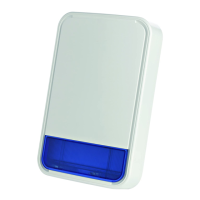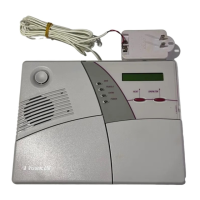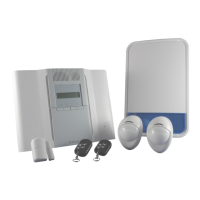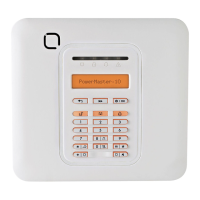DE5110 11
and waits 4 seconds for a
KISSOFF signal. Upon
KISSOFF, the communi-
cator checks whether
another event is waiting
to be reported (alarms
are always reported be-
fore restorals).
(5)
If there is a second event
to be reported, the com-
municator reports it and
disengages the line upon
reception of KISSOFF for
the second event. The
communication session is
considered successful.
Figure 4.1 The DL-1000
Communicator
Note: Without KISSOFF from the central station, messages will
be repeated until the factory default number of "message
repetitions" is reached. Next, the second (backup) telephone
number will be called and a communication session will be
attempted. If this fails too, the COMMUNICATION FAILURE
code will be sent to the control module, which will produce the
relevant TROUBLE indications.
(6)
Upon completion of a successful or ineffective communication
session with the first central station, and provided that the
communicator has been programmed to call the second central
station, the entire procedure will be repeated, but this time with
the telephone numbers of the second central station.
B. Reporting to Private Telephones
Unlike central stations, private telephones are not equipped to
interpret event codes. When programmed to report to a private
telephone, the communicator transmits only two types of alarm
tone signals over the telephone line:
•
A two-tone siren to indicate an alarm in a regular zone.
•
A swept-tone siren to indicate an alarm in a 24-hour zone.
In Private Telephone mode, the first telephone number becomes a
"follow me" number, which is programmed by the master user
each time before arming the alarm system and which will be
deleted automatically upon disarming. The other 3 numbers are
programmed by the installer as permanent reporting destinations.
Once triggered into operation by the occurrence of an event, the
communicator carries out the following sequence of operations:
(1)
It seizes the line and waits 10 seconds for dialing tone.
(2)
Upon detection of a 2-second long dialing tone, the commu-
nicator starts calling the "follow me" number. If no such number
is programmed, the first of the other 3 numbers will be dialed.
Note: If there is no dial tone, the communicator goes "on hook"
for about 5 seconds, then seizes the line again and waits once
more for dial tone. If there is still no tone, dialing starts anyway,
except in cases where a hexadecimal "D" is programmed as a
prefix to the telephone number. With a D-prefix, dialing will not
take place unless a dial tone is detected.
(3)
Once called party answers, communicator waits 5 seconds and
transmits relevant signal (two-tone or swept siren, depending
on the type of alarm event). The siren sounds for 15 seconds
and stops for 5 seconds, throughout which communicator
stands by for an acknowledgement (DTMF "0" or "2").
DTMF
"0"
will cause the communicator to consider the
communication session successful and cease any activity.
DTMF
"2"
will cause the communicator to consider the event
closed for the presently contacted telephone only, but to
continue calling the remaining telephone numbers.
Note: Without an acknowledgement, the siren will sound the
maximum number of times allowed by factory programming (5
times). The communicator will then disengage the line and call
the other telephone numbers by order of priority. Each
telephone will be called the maximum number of times allowed
by factory programming, unless proper acknowledgement is
received by the communicator.
(4)
If a 24-hour zone alarm occurs while a regular alarm is being
reported, the communicator will automatically switch to the
swept-tone alarm.
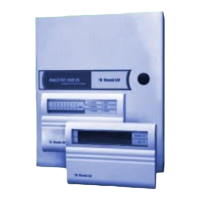
